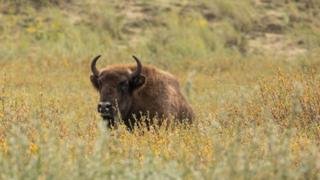
Image copyright
Kent Wildlife Trust
Bison will be introduced to UK woodland to restore an ancient habitat and its wildlife, conservationists have said.
The £1m project, led by Kent Wildlife Trust and the Wildwood Trust, is aimed at helping to manage Blean Woods near Canterbury.
A wild herd of European bison, the continent’s largest land mammal, will be in their new home by spring 2022.
The breed is the closest living relative to ancient steppe bison, which once roamed Britain.
Image copyright
Kent Wildlife Trust
The charities will be preparing over the next 18 months, including creating a fenced enclosure.
The bison will be within a wider 500 hectare (1,200 acre) area with other grazing animals such as Konik ponies, to create varied and healthy habitat, the conservationists said.
- The European bison is slightly larger and longer-legged that the American bison, but is less heavy
- The European bison’s range originally extended eastward across Europe to the Volga River and the Caucasus Mountains
- Herds were established from zoo-bred animals in Belarus, Poland, Lithuania, Russia and Ukraine
Source: Encyclopaedia Britannica
Paul Hadaway, of Kent Wildlife Trust said: “A wilder, nature-based solution is the right one to tackling the climate and nature crisis we now face.
“Using missing keystone species like bison to restore natural processes to habitats is the key to creating bio-abundance in our landscape.”
Image copyright
Kent Wildlife Trust
Paul Whitfield, director general of Wildwood Trust added: “This will allow people to experience nature in a way they haven’t before.”
Adult males can weigh up to a tonne but bison are peaceful, according to the experts, and no other species could perform the job of engineering the habitat in quite the same way.
They fell trees by rubbing up against them, creating areas of space and light in the woods, which help plants such as cow wheat to grow.
The heath fritillary – a rare butterfly – depends on this plant.
Image copyright
Kent Wildlife Trust
Patches of bare earth created by the bison dust bathing are good for lizards and rare arable weeds, while their bark stripping creates standing deadwood for fungi and insects such as stag beetles.
The project is to be funded by £1,125,000 from the People’s Postcode Lottery Dream Fund.
Read MoreFeedzy


